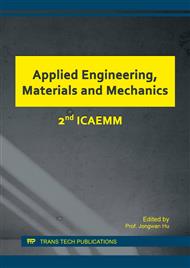[1]
W. B. Gao. Theory and design method of variable structure control. Science Press, (1996).
Google Scholar
[2]
H. Li, P. Shi, D. Yao. Adaptive Sliding Mode Control of Markov Jump Nonlinear Systems with Actuator Faults. IEEE Trans. Autom. Contr. 62(4) (2017) 1933-(1939).
DOI: 10.1109/tac.2016.2588885
Google Scholar
[3]
M. H. Khooban, T. Niknam, F. Blaabjerg, et al. Free chattering hybrid sliding mode control for a class of non-linear systems: electric vehicles as a case study. Iet Sci. Measur. Tech. 10(7) (2016) 776-785.
DOI: 10.1049/iet-smt.2016.0091
Google Scholar
[4]
P. Yang, J. Ni, X. Pan, et al. Global Robust Sliding Mode Control for Time-Delay Systems with Mismatched Uncertainties. Circ. Syst. Sign. Proc. 35(8) (2016) 3015-3026.
DOI: 10.1007/s00034-015-0172-8
Google Scholar
[5]
I. Podlubny. Fractional Differential Equations, Mathematics in Science and Engineering. (1999).
Google Scholar
[6]
F. Lorenzo, T. T. Hartley, Generalized functions for the fractional calculus, NASA TP-1999-209424, (1999), pp.39-55.
Google Scholar
[7]
N. Z. Wang. Sliding mode variable structure control based on fractional calculus theory, Nanjing Forestry University master's thesis. (2010), pp.21-30.
Google Scholar
[8]
M. P. Aghababa, No-chatter variable structure control for fractional nonlinear complex systems, Nonlin. Dyn. 73(4) (2013) 2329-2342.
DOI: 10.1007/s11071-013-0944-2
Google Scholar
[9]
J. Luo, H. Liu. Adaptive Fractional Fuzzy Sliding Mode Control for Multivariable Nonlinear Systems, Discr. Dyn. Nat. Soc. 2014(6) (2014) 1-10.
Google Scholar
[10]
C. Yin, Y. H. Cheng, S. M. Zhong, Z. B. Bai. Fractional order switching type control law design for adaptive sliding mode technique of 3D fractional order nonlinear systems. Complexity, 21(6) (2016) 363–373.
DOI: 10.1002/cplx.21696
Google Scholar
[11]
B. Jakovljević, A. Pisano, M. R. Rapaić, E. Usai. On the sliding – mode control of fractional-order nonlinear uncertain dynamics. Int. J. Rob. Nonlin. Contr. 26(4) (2016)782-798.
DOI: 10.1002/rnc.3337
Google Scholar
[12]
Z. Ling. The Sliding Model Control with Varying Structure for Semi-Active Suspensions in Vehicle. J. Vibr. Eng. 16(4) (2003) 457-462.
Google Scholar
[13]
J. X. Yang, N. Chen, J. L. Yao, W. Y. Cai. The nonlinear vehicle semi-active suspension model following variable structure control. Nanjing Forestry University (Nat. Sci. Ed. ) 31(1) (2007) 42-46.
Google Scholar
[14]
S. Toyama, F. Ikeda. Integral sliding mode control for active suspension systems of half-vehicle model. Mech. Eng. J. 2(3) (2015) 14-00550-14-00550.
DOI: 10.1299/mej.14-00550
Google Scholar
[15]
L. Xiao, Y. Zhu. Passivity-based integral sliding mode active suspension control. IFAC Proc. Vol. 47(3) (2014) 5205-5210.
DOI: 10.3182/20140824-6-za-1003.00536
Google Scholar
[16]
Y. M. Sam, N. M. Suaib, J. H. S. Osman. Proportional integral sliding mode control for the half-car active suspension system with hydraulic actuator, Wseas International Conference on Robotics, Control and Manufacturing Technology. World Scientific and Engineering Academy and Society (WSEAS), (2008).
DOI: 10.1109/tencon.2002.1182644
Google Scholar
[17]
M. J. Zheng, X. L. Zhang, W. Wen-Jiang, et al. Sliding Mode Variable Structure Control of Semi-Active Air Suspension. Mach. Des. Manuf. (1) (2015) 87-90.
Google Scholar
[18]
K. K. Young. Design of variable structure model-following control systems]. IEEE Trans. Autom. Contr. AC-23(6) (1977) 1079-1085.
DOI: 10.1109/tac.1978.1101913
Google Scholar
[19]
J. K. Liu. The basic theory and design method of MATLAB simulation of sliding mode variable structure control (Third Edition). Beijing: Tsinghua University press, 2015, 33-78, 110-115.
Google Scholar
[20]
N. M. Qi, C. M. Qin, W. Wang. Optimal Oustaloup digital realization of fractional order systems. Contr. Decis. (10) (2010) 1598-1600.
Google Scholar


